Superelevation
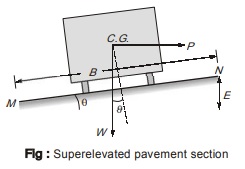
In order to reduce the effect of centrifugal force apart from lateral friction, the outer edge of the pavement is raised with respect to inner edge and hence a transverse slope is provided along length of horizontal curve. This transverse inclination is known as ‘superelevation’. The rate of superelevation ‘e’ is expressed as ratio of height of outer edge with respect to horizontal width of pavement.
In figure, superelevation, e = tanθ
= NL / ML
It is usual practice to keep value of ‘e’ very small i.e. less than 0.07, so, θ is very small and tanθ sinθ
So, e = sinθ
= NL / ML = E/B
Where E is height of outer edge w.r.t inner edge in figure and B is width of road.
Using eq. (ii) instead of (i) calculation of superelevation is convenient because horizontal width of road i.e. ML(in figure) is difficult to measure.
Now, if ‘e’ is superelevation to be provided on road and ‘B’ is width of road then height of outer edge that has to be raised w.r.t. inner edge, E = eB [Using eq. (ii)]
Analysis of Superelevation
Consider a vehicle negotiating on a horizontal curve as shown in figure below.
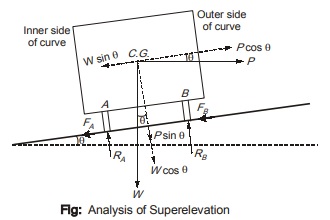
In this figure, various forces acting on vehicle along with the superelevation provided are shown.
As it is clear from figure that the centrifugal force acting on vehicle is opposed by:
(i) Friction developed between tyres and road surface.
(ii) A component of weight which is now acting as a opposing force due to superelevation provided on road.
Now, to analyze the forces on vehicle consider the equilibrium of vehicle in a plane parallel to pavement surface
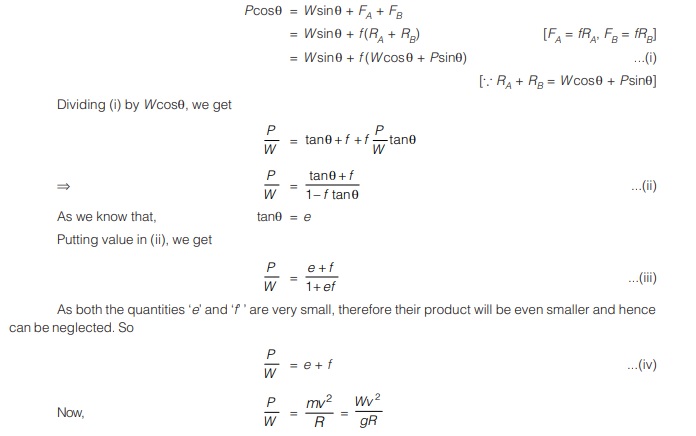
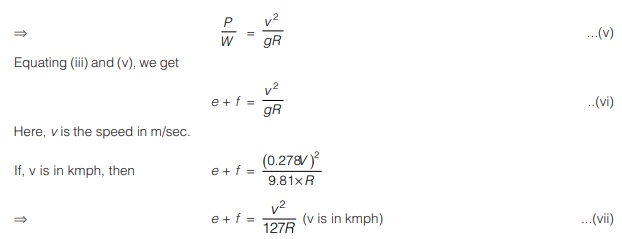
Equation (vii) implies that superelevation ‘e’ and coefficient of lateral friction ‘f’ combinedly opposes the effect of centrifugal force. But in actual, the maximum value of superelevation ‘e’ is 0.07 while minimum value of coefficient of lateral friction ‘f ’ is taken as ‘0.15’. Hence, it can be inferred that although superelevation ‘e’ and coefficient of friction ‘f ’ both combinedly opposes centrifugal force, but it is mainly the friction that is opposing the effect of centrifugal force. Sometimes, it is not possible to provide superelevation on horizontal curves then only friction balances the centrifugal forces acting on vehicle. Hence equation (vii) can be written as
f = V2 / 127R
V = √127fR
Maximum superelevation
Value of superelevation that is required on road increase with increase in speed and also increases with decrease in radius of horizontal curve if coefficient of lateral friction ‘f ’ is kept constant. However, it is necessary from practical point of view to put a limit on the value of superelevation that can be provided on road.
Maximum value of superelevation as per IRC.
| S. No. | Type of terrain | Super-elevation (in %) |
|---|---|---|
|
1. 2. 3. |
Plain and rolling terrains and snow bound areas Hill roads not bound by snow Urban road with frequent intersections |
7 10 4 |
Minimum superelevation
As discussed earlier, it is necessary to provide a minimum cross-slope from drainage point of view. If the calculated superelevation is less than camber that is provided on road surface, then minimum superelevation that is to be provided on road can be taken equal to camber of pavement surface. In that case, crown of camber is eliminated and uniform cross slope equal to camber is maintained from outer to inner edge of pavement at horizontal curve.
In curves with vary large radius, superelvetion required will be very less and camber can be considered as required superelevetion. However it will cause a negative superelevation on outer half of pavement. Centrifugal force along with negative superelevation will be less than coefficient of lateral friction. Thus, IRC has listed a table giving the radii of horizontal curve beyond which no superelevation is required at horizontal curve and camber can be considered as superelevation.
| Radii beyond which superelevation is not required | |||||
|---|---|---|---|---|---|
|
Design speed (kmph) |
Radii (metre) of horizontal curve for camber of |
||||
| 4% | 3% | 2.5% | 2% | 1.7% | |
|
20 25 30 35 40 50 65 80 100 |
50
70 100 140 180 280 470 700 1100 |
60
90 130 180 240 370 620 950 1500 |
70
110 160 220 280 450 750 1100 1800 |
90
140 200 270 350 550 950 1400 2200 |
100 150 240 320 420 650 1100 1700 2600 |
Extrawidening
If the radius of pavement is not large on a horizontal curve, then it is a common practice to widen the pavement more than the normal width. The reason for providing more width of pavement than normal can be listed as follows:
- Whenever an automobile such as car, bar or truck takes a turn to negotiate on a horizontal curve, only the front wheels can be turned. While negotiating the curve, rear wheels of vehicle do not follow the same path as that followed by front wheels due to rigidity of wheel base. It is called as ‘off tracking’. Generally at low speed and upto design speeds, there is no lateral slipping of rear wheels and the wheels on rear side follow inner path on the curve as compared with those of corresponding front wheels. It can be said that if inner front wheel will take a path on inner edge of curve, then inner rear wheel will be off the pavement. Thus, off tracking depends on:
(a) Length of wheel base of vehicle
(b) Turning angle or radius of horizontal curve - When a vehicle is moving at a higher speed, than the design speed and combination of superelevation provided on road and lateral friction developed on road is not sufficient to balance the outward thrust on vehicle due to centrifugal force acting on wheel, then there is a possibility of skidding of rear wheels of vehicle in outward direction. To prevent skidding of rear wheel, vehicle will need more width on pavement. It is a another reason for providing extra widening on road to provide safety measure for accidental skidding. However, it is to be noted that it occurs only at a very high speed.
- While negotiating a curve, drivers have tendency to use the outer side at beginning of curve so that they can have greater visibility and attaining the curved path with large radius.
Analysis of extra widening on horizontal curves:
Total extrawidening provided on road comprises of two parts:
(a) Mechanical Extrawidening
(b) Psychological Extrawidening
(a) Mechanical Extrawidening: This part of extrawidening is required to avoid offtracking of rear wheels due to rigidity of wheel base of vehicle and may be calculated as follows:
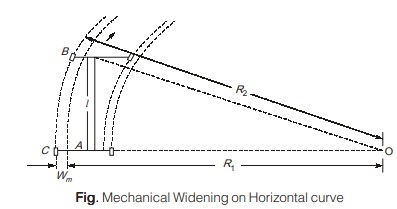
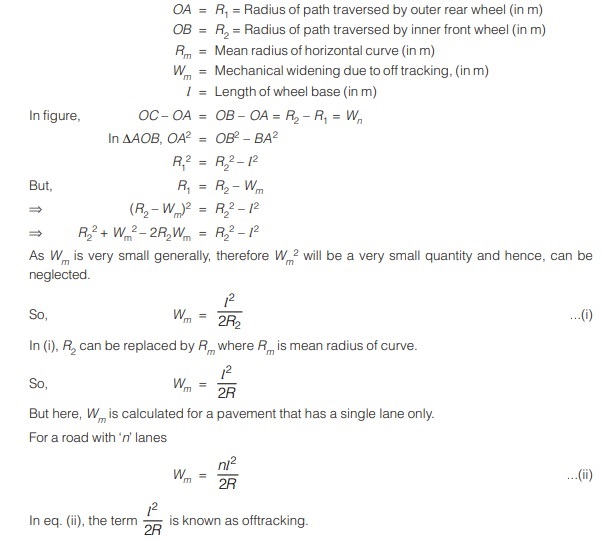
(b) Psychological Widening: Whenever drives negotiate a horizontal curve, they have a tendency to maintain a greater clearance between their vehicles than on straight stretch of road. Hence, for psychological reasons also, extrawidening is provided on the road so that drivers can have greater maneuverability of steering at higher speeds. It is therefore important in roads with more than one lanes to one lanes increase the width of road.

<< Previous | Next >>
Must Read: What is Highway Engineering?

